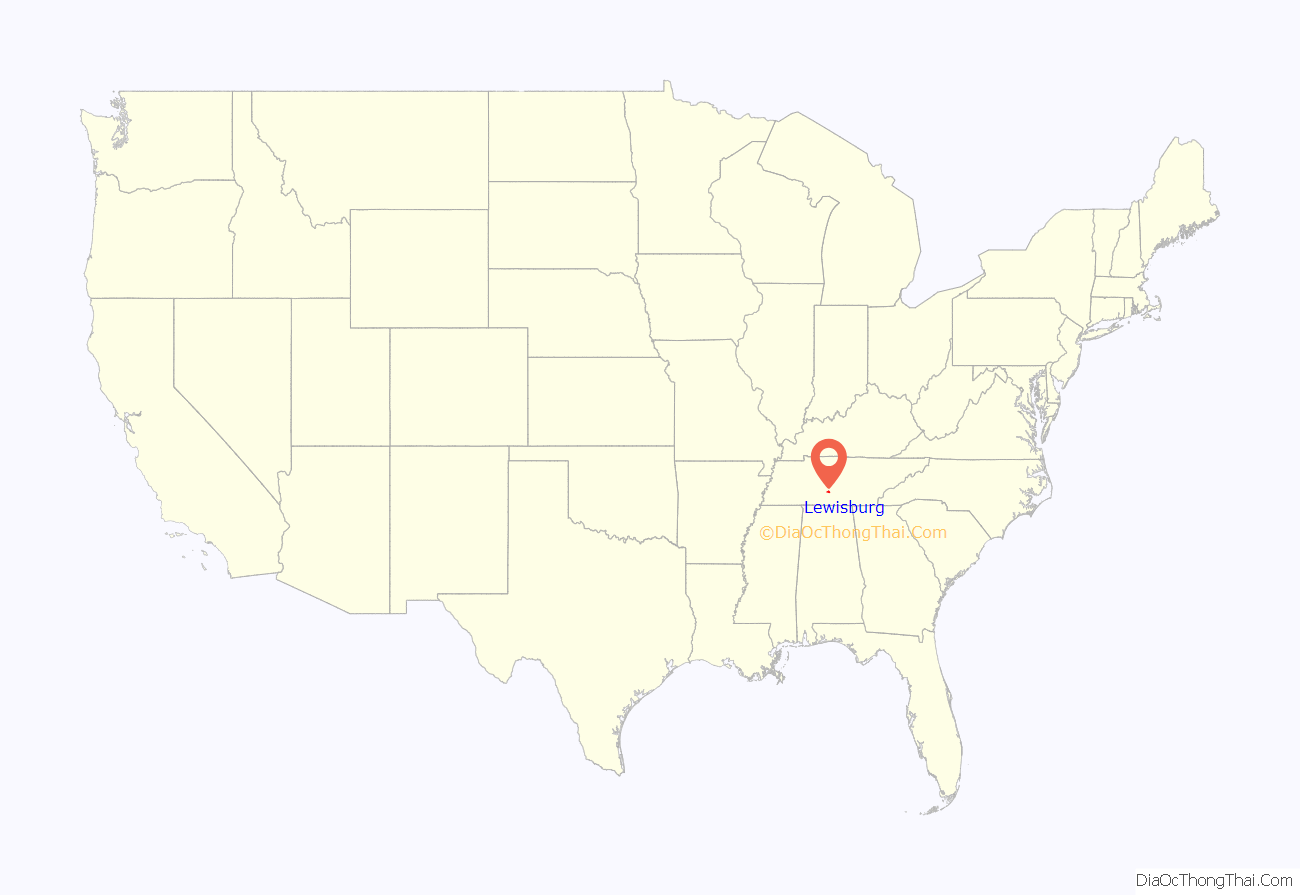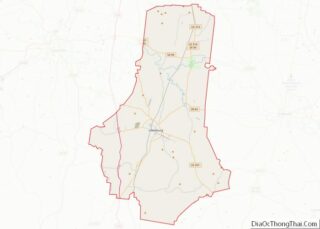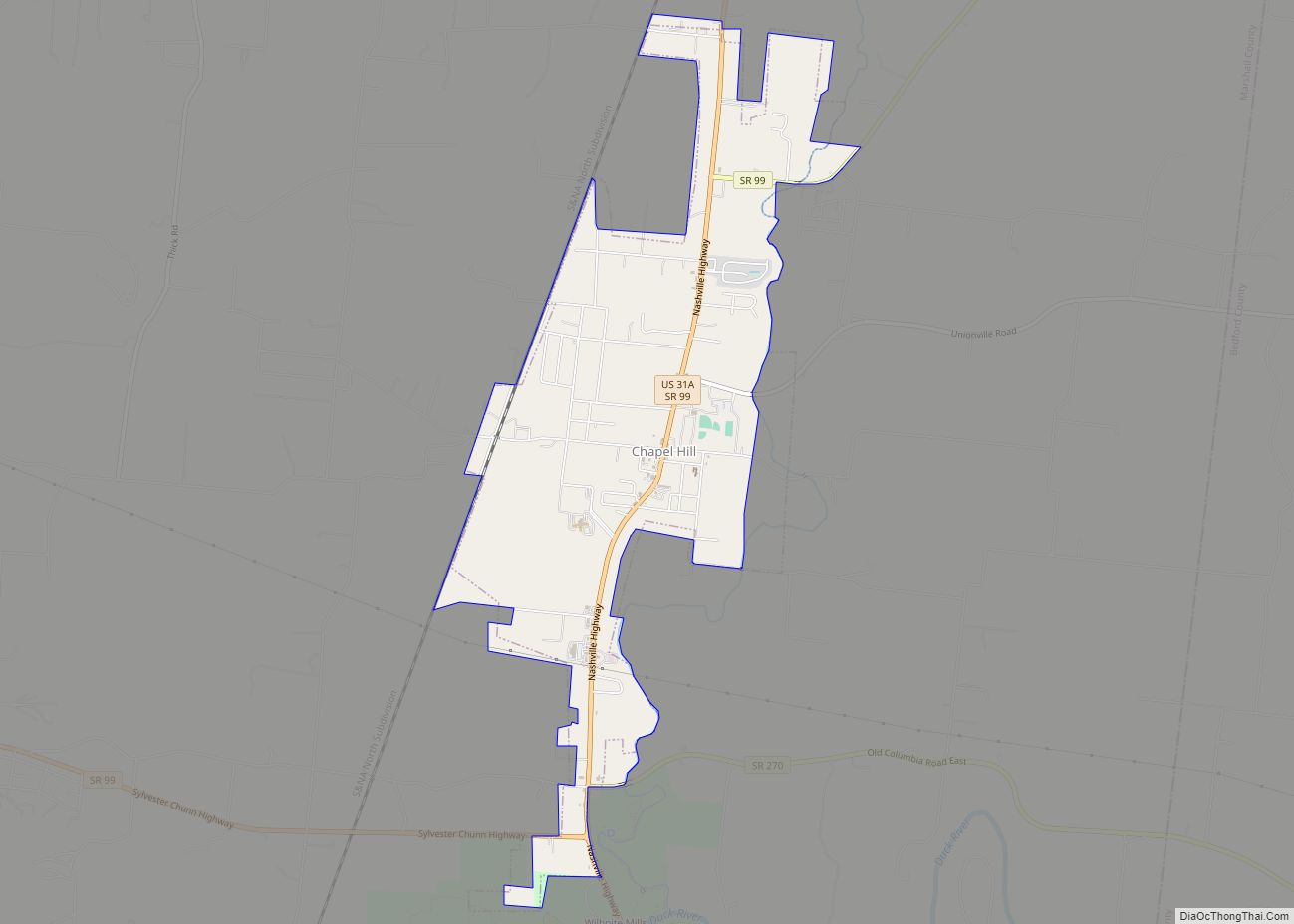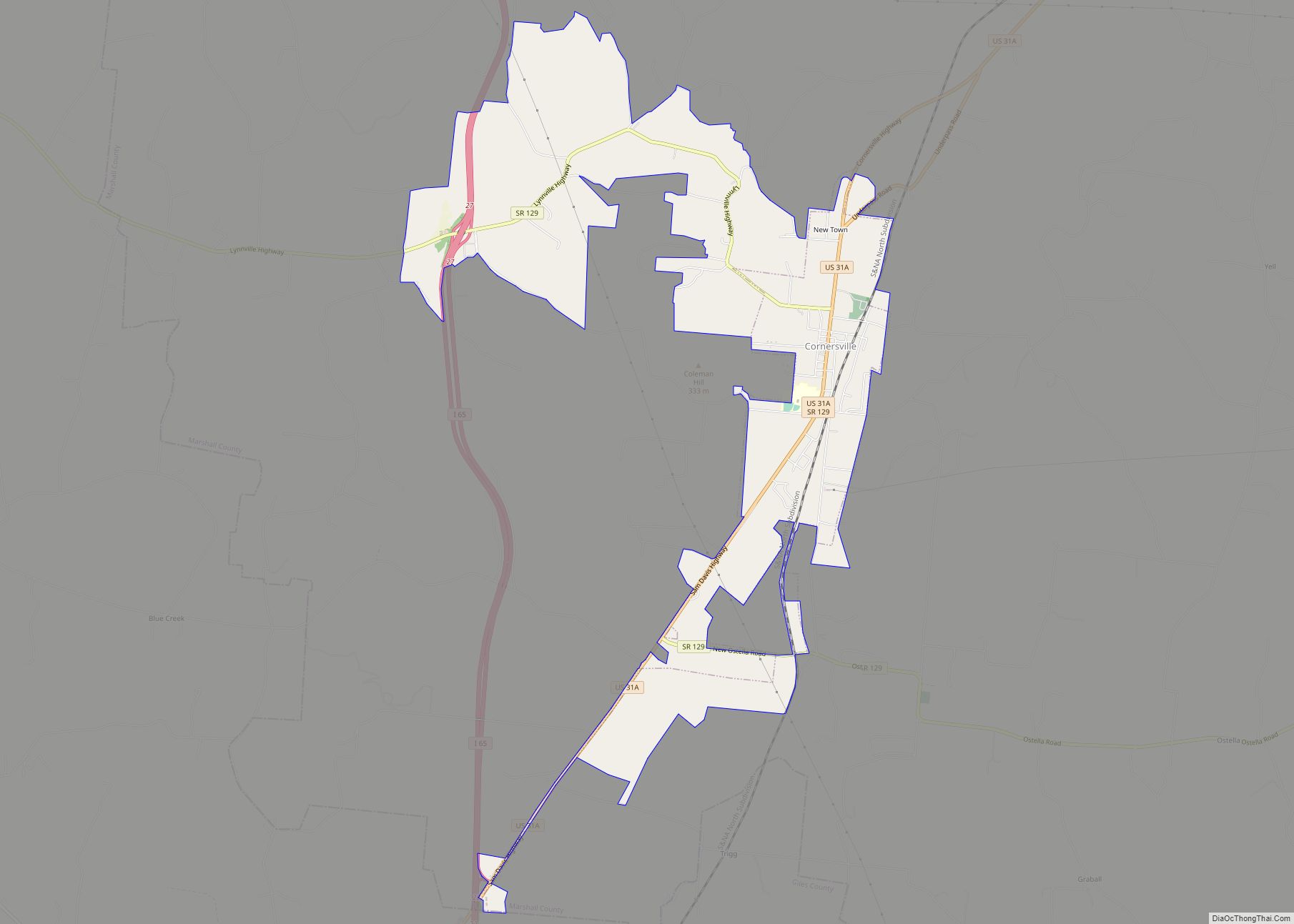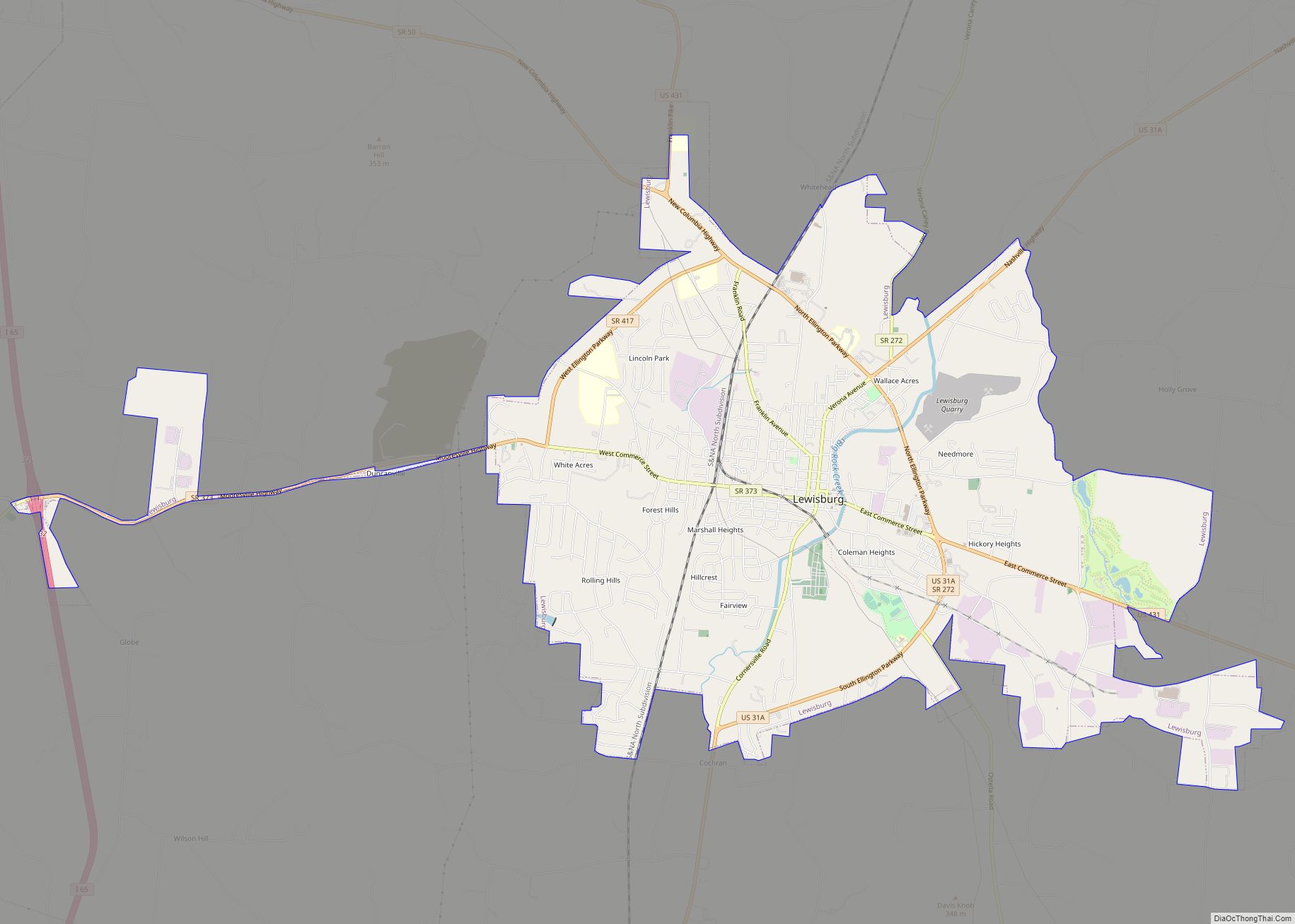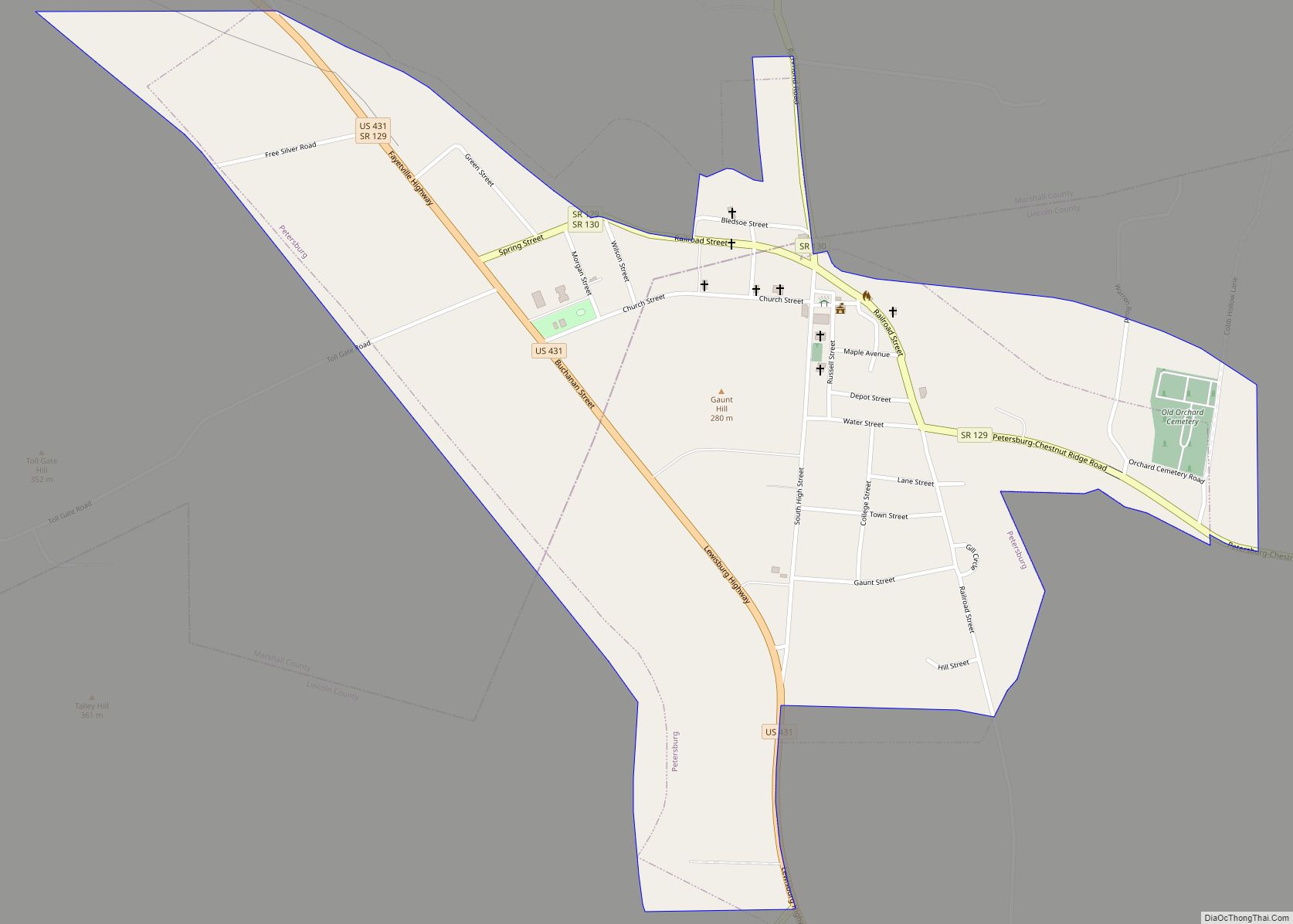Lewisburg is a city in, and the county seat of Marshall County, Tennessee, United States. The population was 12,288 in 2020. Lewisburg is located in Middle Tennessee, fifty miles south of Nashville and fifty-two miles north of Huntsville, Alabama. Residents have access to the larger cities via nearby I-65.
Located among rolling hills, Lewisburg was named for the explorer Meriwether Lewis. By 1838, the town was supporting a newspaper and a bank. The downtown area is similar to many other small southern towns, with a courthouse on a square, surrounded by retail and commercial businesses. Shopping centers are located on the east and west ends of town.
| Name: | Lewisburg city |
|---|---|
| LSAD Code: | 25 |
| LSAD Description: | city (suffix) |
| State: | Tennessee |
| County: | Marshall County |
| Incorporated: | 1837 |
| Elevation: | 738 ft (225 m) |
| Total Area: | 14.05 sq mi (36.39 km²) |
| Land Area: | 14.04 sq mi (36.37 km²) |
| Water Area: | 0.01 sq mi (0.01 km²) |
| Total Population: | 12,288 |
| Population Density: | 874.96/sq mi (337.83/km²) |
| ZIP code: | 37091 |
| Area code: | 931 |
| FIPS code: | 4741860 |
| GNISfeature ID: | 1291094 |
| Website: | www.lewisburgtn.gov |
Online Interactive Map
Click on ![]() to view map in "full screen" mode.
to view map in "full screen" mode.
Lewisburg location map. Where is Lewisburg city?
History
The area in which Lewisburg and Marshall County is located was long occupied by various cultures of indigenous peoples. Historic Native Americans were here when French, Spanish and English explorers entered the area. Revolutionary War veterans were given land grants in this area by the State of North Carolina for services rendered during the war followed in the 1780s. North Carolina still claimed this territory under its colonial charter, but later gave up that claim and Tennessee became an independent state.
Marshall County, named in honor of the young nation’s first Supreme Court Chief Justice and noted American jurist, John Marshall, was established by an act of the Tennessee General Assembly in 1836. The act which created the county specified that the county seat be named Lewisburg to commemorate the deeds of frontier explorer Meriweather Lewis. He had been leader of the Lewis and Clark Expedition to explore the Louisiana Territory soon after its purchase. Lewisburg was incorporated in 1837, on a site of 50 acres (200,000 m) donated for civic purpose.
There was white violence against freedmen during and after Reconstruction, extending into the early 20th century. Some lynchings of African Americans took place at the Marshall County Courthouse in Lewisburg during the period of highest violence around the turn of the 20th century. Two unidentified black men were lynched without trial in Lewisburg on August 5, 1903. Another account said that John Milligan (Millikin) and John L. Hunter had been killed in Needmore by a mob that week. They are likely the same men.
Until 1925, Lewisburg served the area principally as a trading and shipping center for its livestock and farm produce. As the county seat, it was a center of the justice system and active as a retail center for the area farmers.
The world headquarters of the Tennessee Walking Horse Breeders’ and Exhibitors’ Association has been based in Lewisburg since 1939. The Tennessee Walking Horse, a gaited breed, is considered to have been developed in Middle Tennessee, and the area is still a center of breeding and exhibitions for this horse.
Marshall County is significant partly because of three men who have served as Governor of Tennessee were living here when they were elected to office: Henry Horton, Jim Nance McCord, and Buford Ellington.
Today, Lewisburg/Marshall County is the home of several nationally known industries. Due to restructuring and movement of industry offshore, it has suffered thousands of job losses in recent years, but it maintains a viable work force.
Lewisburg Road Map
Lewisburg city Satellite Map
Geography
Lewisburg is located at 35°26′57″N 86°47′35″W / 35.44917°N 86.79306°W / 35.44917; -86.79306 (35.449034, -86.793112).
According to the United States Census Bureau, the city has a total area of 11.7 square miles (30 km), almost all of which is land (0.09% is water).
Climate
See also
Map of Tennessee State and its subdivision:- Anderson
- Bedford
- Benton
- Bledsoe
- Blount
- Bradley
- Campbell
- Cannon
- Carroll
- Carter
- Cheatham
- Chester
- Claiborne
- Clay
- Cocke
- Coffee
- Crockett
- Cumberland
- Davidson
- Decatur
- DeKalb
- Dickson
- Dyer
- Fayette
- Fentress
- Franklin
- Gibson
- Giles
- Grainger
- Greene
- Grundy
- Hamblen
- Hamilton
- Hancock
- Hardeman
- Hardin
- Hawkins
- Haywood
- Henderson
- Henry
- Hickman
- Houston
- Humphreys
- Jackson
- Jefferson
- Johnson
- Knox
- Lake
- Lauderdale
- Lawrence
- Lewis
- Lincoln
- Loudon
- Macon
- Madison
- Marion
- Marshall
- Maury
- McMinn
- McNairy
- Meigs
- Monroe
- Montgomery
- Moore
- Morgan
- Obion
- Overton
- Perry
- Pickett
- Polk
- Putnam
- Rhea
- Roane
- Robertson
- Rutherford
- Scott
- Sequatchie
- Sevier
- Shelby
- Smith
- Stewart
- Sullivan
- Sumner
- Tipton
- Trousdale
- Unicoi
- Union
- Van Buren
- Warren
- Washington
- Wayne
- Weakley
- White
- Williamson
- Wilson
- Alabama
- Alaska
- Arizona
- Arkansas
- California
- Colorado
- Connecticut
- Delaware
- District of Columbia
- Florida
- Georgia
- Hawaii
- Idaho
- Illinois
- Indiana
- Iowa
- Kansas
- Kentucky
- Louisiana
- Maine
- Maryland
- Massachusetts
- Michigan
- Minnesota
- Mississippi
- Missouri
- Montana
- Nebraska
- Nevada
- New Hampshire
- New Jersey
- New Mexico
- New York
- North Carolina
- North Dakota
- Ohio
- Oklahoma
- Oregon
- Pennsylvania
- Rhode Island
- South Carolina
- South Dakota
- Tennessee
- Texas
- Utah
- Vermont
- Virginia
- Washington
- West Virginia
- Wisconsin
- Wyoming
